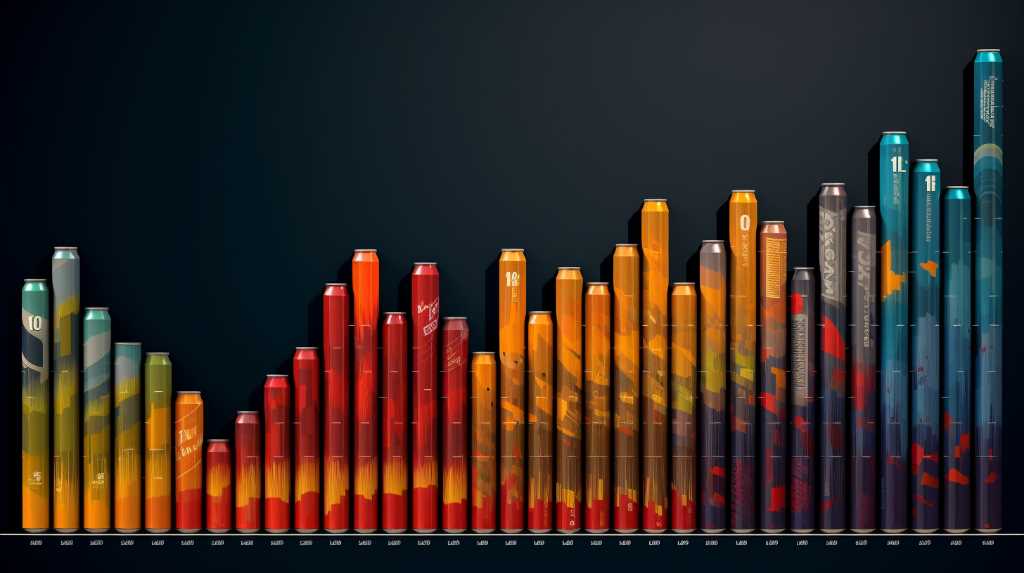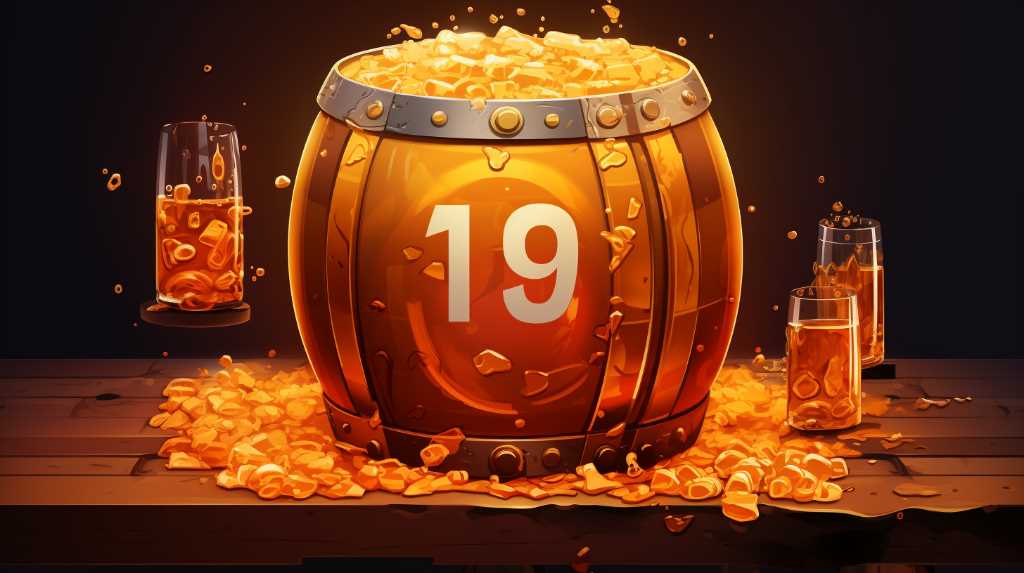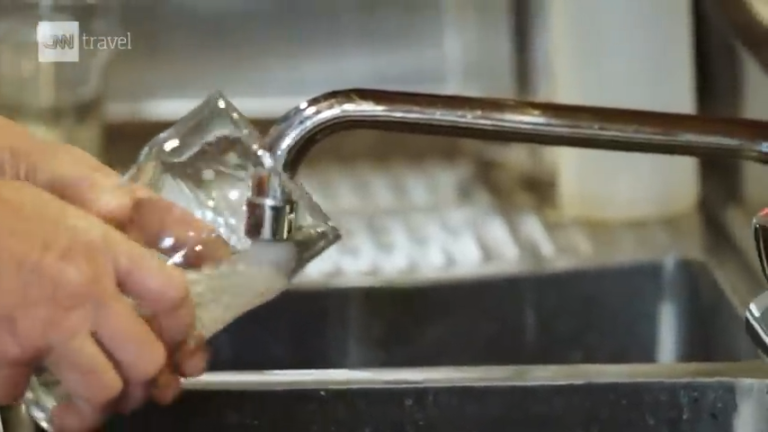How Many Beers In A Keg? (With Basic Computation)

Are you ready to explore the world of keg sizes and beer quantities? Well, grab a cold one and get ready to learn!
In this article, we’ll walk you through the basic calculations to determine how many beers are in different keg sizes. Whether you’re planning a big party or just want to stock up for yourself, understanding the capacity of each keg size is important.
So, let’s dive in and make sure everyone has enough to drink at your gathering!

Half-Barrel Keg Capacity
Calculating the capacity of a half-barrel keg is a simple process. This keg size, also known as a full keg, can hold 15.5 gallons of beer. That’s equivalent to approximately 124 16 fluid ounce beers or 165.333333 12 fluid ounce beers.
Now, let’s discuss the different types of beer that are commonly served in half-barrel kegs. From light lagers to rich stouts, half-barrel kegs can accommodate a wide range of beer styles. Whether you prefer a crisp pilsner, a hoppy IPA, or a smooth porter, there’s a beer for everyone in this keg size.
To ensure the best drinking experience, it’s important to keep the keg refrigerated to maintain freshness. Additionally, using a proper dispensing system and keeping the keg upright during transportation will help preserve the quality of the beer.

Cheers to enjoying your favorite brews from a half-barrel keg!
Quarter-Barrel Keg Capacity
Determining the capacity of a quarter-barrel keg involves understanding how many beers it can hold. A quarter-barrel keg, also known as a Pony keg, has a volume of 7.75 gallons. This smaller size is perfect for intimate gatherings or small parties. In terms of beer quantity, a quarter-barrel keg can accommodate approximately 82.67 beers (16 fluid ounces) or 110.67 beers (12 fluid ounces).
To offer a clearer comparison, let’s take a look at the cost effectiveness of quarter-barrel kegs versus half barrel kegs:
- Quarter Barrel: 82.67 beers (16 fl oz) or 110.67 beers (12 fl oz)
- Half Barrel: 124 beers (16 fl oz) or 165.33 beers (12 fl oz)
Craft beer enthusiasts often prefer quarter-barrel kegs due to their smaller size, which makes them more manageable for personal use or smaller gatherings. These kegs are popular because they allow for a diverse selection of craft beers without committing to large quantities. Additionally, quarter-barrel kegs offer the advantage of being more cost-effective compared to half-barrel kegs, enabling enthusiasts to enjoy a variety of craft brews at a reasonable price.

As the demand for craft beer continues to rise, quarter-barrel kegs provide a convenient and economical solution for those seeking a taste of the craft beer world without overwhelming quantities.
Sixth-Barrel Keg Capacity
The capacity of a sixth-barrel keg, also known as a Sixtel or Torpedo keg, is 5.16 gallons. This translates to approximately 41.28 beers if each beer is 16 fluid ounces or 55.04 beers if each beer is 12 fluid ounces.
When it comes to homebrewing, sixth barrel kegs have their advantages and disadvantages.
On the positive side, they’re smaller and easier to manage compared to larger kegs, making them perfect for personal use or dual to triple tap kegerators. They’re also more convenient to transport and store.

However, the smaller size means you’ll have fewer beers available, which may be a downside for larger gatherings or events. In terms of cost per beer, sixth barrel kegs are generally more expensive compared to larger kegs.
It’s important to consider your specific needs and preferences when deciding which keg size to use for homebrewing.
Cornelius Keg Capacity
Cornelius Keg Capacity
A Cornelius keg can hold approximately 53.3333333 beers if each beer is 16 fluid ounces or 64 beers if each beer is 12 fluid ounces. This makes it a popular choice for homebrewers and small batch beer enthusiasts.

But there are more reasons why you should consider using a Cornelius keg for homebrewing:
Easy to clean: Cleaning a Cornelius keg is simple. Just take apart the keg, soak the parts in a cleaning solution, scrub off any residue, and rinse thoroughly.
Portable: The compact size of a Cornelius keg makes it easy to transport. Whether you’re bringing your homebrew to a friend’s party or going on a camping trip, you can take it with you without any hassle.
Versatile: Cornelius kegs can be used for both carbonated and non-carbonated beverages, making them suitable for a wide range of homebrewing experiments.

Cost-effective: Investing in a Cornelius keg can save you money in the long run. They’re reusable, eliminating the need for disposable bottles or cans.
Precise dispensing: With a Cornelius keg, you have more control over the carbonation and dispensing process. This ensures that every pour is just right.
Using a Cornelius keg for homebrewing offers convenience, versatility, and cost savings. It’s a practical choice for beer enthusiasts who want to take their brewing to the next level.
Mini Keg Capacity
How many beers can you fit in a mini keg?

Mini kegs, also known as disposable kegs or bubbas, have a capacity of 1.32 gallons, which is equivalent to approximately 10.56 beers if each beer is 16 fluid ounces or 14.08 beers if each beer is 12 fluid ounces.
While mini kegs have a smaller capacity compared to larger keg sizes, they offer several benefits for homebrewing enthusiasts.
One advantage is their portability and convenience, making them great for travel or solo drinking. Additionally, their smaller size allows for quicker carbonation and aging, reducing the wait time for enjoying your homebrewed beer.
Lastly, mini kegs are cost-effective, especially for smaller gatherings or personal use, when considering the cost per beer.

Calculation for Half-Barrel Kegs
To calculate the number of beers in a half-barrel keg, we need to consider the keg’s size and capacity. A half-barrel keg, also known as a full keg, can hold 15.5 gallons of beer.
Several factors can affect the number of beers you can get from a half-barrel keg:
- Beer Glass Size: The number of beers will vary depending on whether you use a 16 fluid ounce glass or a 12 fluid ounce glass.
- Pour Size: The amount of beer poured into each glass can also impact the total number of beers. A standard pour is usually around 16 fluid ounces.
- Efficiency of Pouring: The skill of the person pouring the beer can affect how much beer is wasted during the process.
- Temperature: The temperature of the beer can influence the amount of foam and therefore the amount of beer in each glass.
- Drinking Speed: The speed at which people consume the beer can also impact the number of beers that can be served from the keg.
When comparing beer consumption at different events using half-barrel kegs, it’s important to consider these factors. For example, at a large party or a bar where people may drink quickly, the number of beers consumed will be higher compared to a smaller gathering where people may drink more slowly.
Understanding these factors can help you estimate the number of beers you’ll need for your event and ensure that everyone enjoys their drinks.

Calculation for Quarter-Barrel Kegs
Calculating the number of beers in a quarter-barrel keg is a straightforward process that involves considering the keg’s size and capacity. A quarter-barrel keg, which is also referred to as a Pony keg, can hold 7.75 gallons of liquid. This amount is equivalent to approximately 82.67 beers if each beer is 16 fluid ounces or 110.67 beers if each beer is 12 fluid ounces.
It’s important to note that a half-barrel keg, which holds 15.5 gallons, can accommodate 124 beers (16 fluid ounces) or 165.33 beers (12 fluid ounces).
When determining how many quarter-barrel kegs to purchase for a party, it’s essential to take into account various factors, such as the number of guests, their drinking preferences, and the duration of the event. Additionally, it’s crucial to be aware of any local regulations pertaining to the purchase and consumption of alcohol.
Calculation for Sixth-Barrel Kegs
Calculating the Number of Beers in a Sixth-Barrel Keg

If you’re wondering about the capacity of a sixth-barrel keg compared to other keg sizes and how many servings it can provide with different glass sizes, here’s what you need to know:
Comparing sixth-barrel kegs to other keg sizes in terms of capacity:
- A half barrel keg holds three times more beer than a sixth-barrel keg.
- A quarter barrel keg holds 1.5 times more beer than a sixth-barrel keg.
- A cornelius keg holds slightly less beer than a sixth-barrel keg.
- A mini keg holds significantly less beer than a sixth-barrel keg.
Estimating the number of servings in a sixth-barrel keg based on different glass sizes:
- If you’re using a 16 fluid ounce glass, a sixth-barrel keg can provide approximately 41 servings.
- If you’re using a 12 fluid ounce glass, a sixth-barrel keg can provide approximately 55 servings.
With this information, you can now determine how many beers you can expect from a sixth-barrel keg and plan your gatherings accordingly. Cheers!

Frequently Asked Questions
Can I Use a Half-Barrel Keg for a Small Party or Personal Use?
Yes, you can definitely use a half-barrel keg for a small party or personal use. However, it’s worth considering other options like quarter-barrel or sixth-barrel kegs, which may be more suitable in terms of size. These smaller keg sizes can still provide plenty of beer for your gathering while being easier to handle and transport. So, if you’re looking for a convenient and manageable option for your party or personal use, consider the alternatives to a half-barrel keg.
How Many Beers Can a Cornelius Keg Hold if I Fill It With Soda Instead of Beer?
A Cornelius keg can hold around 53.33 beers (16 fl oz) or 64 beers (12 fl oz). If you decide to fill it with soda instead of beer, it can still hold the same amount. This makes a Cornelius keg a versatile option for homebrewing soda. So, whether you’re looking to enjoy a cold beer or a refreshing soda, the Cornelius keg has got you covered.
Can I Use a Quarter-Barrel Keg for a Large Party or at a Bar?
Yes, you can definitely use a quarter-barrel keg for a large party or at a bar. This type of keg has a capacity of 7.75 gallons, which means it can hold approximately 82.67 beers if each beer is 16 fluid ounces, or 110.67 beers if each beer is 12 fluid ounces. It’s a convenient option for serving a decent amount of beer without the need for multiple smaller kegs. Whether you’re hosting a big gathering or running a bar, a quarter-barrel keg can help ensure that your guests have plenty of beer to enjoy.
How Many Mini Kegs Would I Need to Buy to Have the Same Amount of Beer as a Half-Barrel Keg?
To have the same amount of beer as a half-barrel keg, you would need to purchase multiple mini kegs. This calculation involves determining the volume of beer in a keg and dividing it by the volume of a mini keg. Let’s break it down further.

A half-barrel keg typically holds around 15.5 gallons of beer. On the other hand, a mini keg usually contains 1.32 gallons of beer. To find out how many mini kegs you would need, you can divide the volume of the half-barrel keg by the volume of a mini keg.
By performing this calculation, you’ll discover that you would need approximately 11.74 mini kegs to match the amount of beer in a half-barrel keg. Keep in mind that this is an estimate and may vary depending on the specific sizes available.
Are There Any Special Considerations or Restrictions When Using a Sixth-Barrel Keg in a Kegerator With Multiple Taps?
When using a sixth-barrel keg in a kegerator with multiple taps, there are some important things to consider. It’s crucial to ensure proper spacing between the kegs to avoid any issues. Additionally, controlling the temperature and maintaining the right CO2 levels is essential for optimal keg performance. By taking these precautions, you can enjoy a smooth and hassle-free pouring experience from your kegerator.






